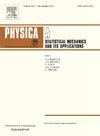Capacity improvement for mixed traffic flow by installing vehicle-to-vehicle devices on partial human-driven vehicles to serve connected automated vehicles
IF 2.8
3区 物理与天体物理
Q2 PHYSICS, MULTIDISCIPLINARY
Physica A: Statistical Mechanics and its Applications
Pub Date : 2025-06-10
DOI:10.1016/j.physa.2025.130763
引用次数: 0
Abstract
Vehicle-to-vehicle (V2V) communication technology in connected automated vehicles (CAVs) substantially improves traffic capacity. During initial CAV deployment phases, mixed traffic flow combining CAVs and human-driven vehicles (HVs) will inevitably co-exist on highways. The absence of V2V capabilities in HVs prevents them from providing V2V services to CAVs, thereby constraining CAVs’ capacity improvement in mixed traffic environments. To address this limitation, we propose equipping partial HVs with V2V communication devices, enabling these retrofitted HVs to transmit V2V information and create essential communication environment for CAVs. This study develops a mixed traffic capacity analysis framework that simultaneously incorporates CAV penetration rate and V2V installation rate of HVs, which aims to improve mixed traffic capacity by adjusting the V2V installation rate of HVs. Firstly, we classified car-following patterns within mixed traffic flow and calculate their probabilities. Secondly, a mixed traffic capacity model was constructed using fundamental diagram theory. Using the established model, critical values for V2V installation rate of HVs were analytically derived to achieve capacity improvements under varying CAV penetration rates. Finally, numerical experiments validated both the model’s reliability and theoretical derivations. Results demonstrate that the proposed model effectively quantifies how CAV penetration rate and V2V installation rate of HVs jointly influence mixed traffic capacity. Strategic adjustment of V2V installation rate of HVs based on each level of CAV penetration rates significantly enhances mixed traffic capacity.
通过在部分人工驾驶车辆上安装车对车设备,为联网自动驾驶车辆提供服务,提高混合交通流量的容量
联网自动驾驶汽车(cav)中的车对车(V2V)通信技术大大提高了交通容量。在自动驾驶汽车的初始部署阶段,自动驾驶汽车和人类驾驶汽车的混合交通流将不可避免地在高速公路上共存。hv缺乏V2V功能,无法为cav提供V2V服务,从而限制了cav在混合交通环境下的容量提升。为了解决这一限制,我们建议为部分hv配备V2V通信设备,使这些改装后的hv能够传输V2V信息,并为cav创造必要的通信环境。本研究建立了同时纳入CAV渗透率和hv V2V安装率的混合交通容量分析框架,旨在通过调整hv V2V安装率来提高混合交通容量。首先对混合交通流中的跟车模式进行分类,并计算其概率;其次,利用基本图理论建立了混合通行能力模型。利用所建立的模型,解析导出了在不同CAV渗透率下hv V2V安装率的临界值,以实现容量提升。最后,通过数值实验验证了模型的可靠性和理论推导。结果表明,该模型有效地量化了自动驾驶汽车普及率和高速公路V2V安装率对混合交通容量的共同影响。根据CAV渗透率的不同层次对hv的V2V安装率进行策略调整,显著提升混合交通容量。
本文章由计算机程序翻译,如有差异,请以英文原文为准。
求助全文
约1分钟内获得全文
求助全文
来源期刊
CiteScore
7.20
自引率
9.10%
发文量
852
审稿时长
6.6 months
期刊介绍:
Physica A: Statistical Mechanics and its Applications
Recognized by the European Physical Society
Physica A publishes research in the field of statistical mechanics and its applications.
Statistical mechanics sets out to explain the behaviour of macroscopic systems by studying the statistical properties of their microscopic constituents.
Applications of the techniques of statistical mechanics are widespread, and include: applications to physical systems such as solids, liquids and gases; applications to chemical and biological systems (colloids, interfaces, complex fluids, polymers and biopolymers, cell physics); and other interdisciplinary applications to for instance biological, economical and sociological systems.

 求助内容:
求助内容: 应助结果提醒方式:
应助结果提醒方式:


